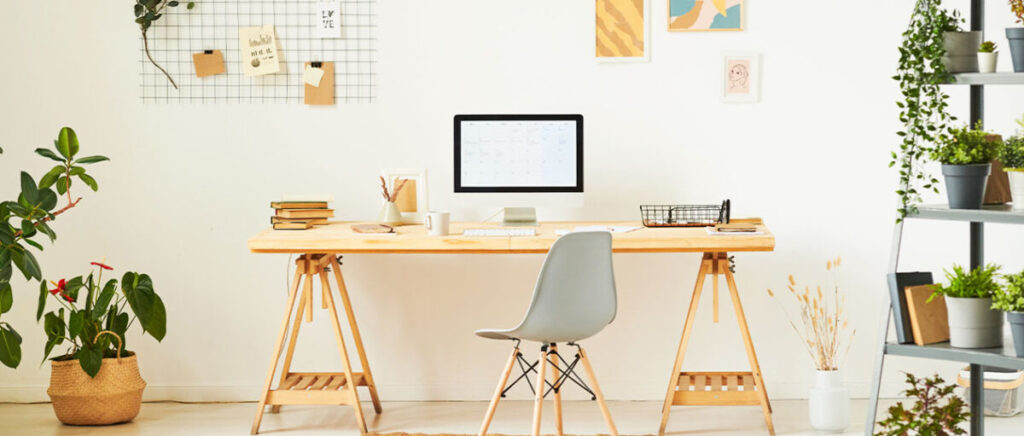Blog
How to Make a Small Study Space Feel Bigger
A small study space can often feel cramped and uninspiring, making it difficult to stay focused and productive. However, with the right design strategies, you can make even the tiniest room feel larger, more open, and more functional. Whether you’re working with a small bedroom corner, a nook, or a dedicated home office, these tips can help you maximize the available space and create a study area that feels airy and comfortable.

1. Opt for Light Colors
The colors you choose for your walls, furniture, and décor can have a significant impact on how spacious your study room feels. Lighter hues, such as whites, soft grays, pale blues, and off-whites, reflect more light and create an open, airy feel. Dark colors, on the other hand, tend to absorb light and can make a small room feel more enclosed.
- Key Tip: Paint the walls in a light, neutral color to make the space feel expansive. You can add pops of color with accessories like pillows, rugs, or artwork for added personality without overwhelming the room.
2. Use Multi-Functional Furniture
In a small study space, every piece of furniture needs to serve more than one purpose. Multi-functional furniture can help you maximize your space without sacrificing functionality or style.
- Key Tip: Look for desks with built-in storage, such as drawers or shelves, to keep your supplies organized. Folding or collapsible furniture is another great option, as it can be easily tucked away when not in use to free up more room.
3. Declutter and Keep It Organized
Clutter is one of the biggest enemies of a small study space. The more things you have out in the open, the smaller and more chaotic the room will feel. Invest in storage solutions that help you keep everything organized and out of sight.
- Key Tip: Use baskets, bins, and shelves to store books, papers, and supplies. Keep your desk clear of unnecessary items, leaving only the essentials that you use regularly. Vertical storage, like wall-mounted shelves, can help you store items without taking up precious floor space.
4. Embrace Vertical Space
When floor space is limited, it’s time to think upwards. Making use of your vertical space by installing wall-mounted shelves or hooks can free up valuable floor area. Floating shelves are an excellent choice for small spaces, as they keep your items organized without occupying too much room.
- Key Tip: Install floating shelves above your desk for books, plants, or decorative items. You can also use vertical organizers for supplies like pens, paper, and folders, keeping them within reach while maximizing floor space.
5. Choose Sleek, Compact Furniture
In a small study area, bulky or oversized furniture can make the room feel cramped. Opt for sleek, compact furniture with a minimalist design to keep the space feeling open and clean. Look for desks with slim profiles and chairs that are both comfortable and space-efficient.
- Key Tip: Consider a wall-mounted desk or a floating desk that takes up minimal space but still provides a functional work surface. For seating, choose a chair with a slim profile or a folding chair that can be tucked away when not in use.
6. Use Mirrors to Create the Illusion of Space
Mirrors are a fantastic tool for making a small room feel bigger and brighter. By reflecting light and creating the illusion of depth, mirrors can visually expand your study space.
- Key Tip: Place a large mirror on one wall or incorporate smaller mirrors into your décor to help open up the space. Be mindful not to overcrowd the room with too many mirrors, as it could make the space feel busy.
7. Keep the Design Simple and Streamlined
When designing a small study space, simplicity is key. Avoid heavy or overly intricate furniture pieces, and instead opt for clean lines and simple, modern designs. This approach helps reduce visual clutter and creates a more open, airy environment.
- Key Tip: Choose furniture that blends seamlessly with the room’s overall design. Avoid too many contrasting patterns or textures, as they can make the space feel fragmented and smaller. Stick with one or two coordinating elements to maintain a cohesive look.
8. Let Natural Light In
Natural light can make a room feel larger and more inviting. Whenever possible, maximize the amount of daylight in your study space by keeping windows clear of heavy curtains or obstructions. Natural light not only brightens the space but also has been shown to improve mood and productivity.
- Key Tip: Use sheer curtains or blinds that allow light to filter through. If your study area lacks natural light, consider adding bright, white lighting to mimic daylight and keep the room feeling fresh and spacious.
9. Add Reflective or Transparent Materials
Incorporating reflective or transparent materials into your study space can help create the illusion of more space. Glass desks, acrylic furniture, and mirrored surfaces reflect light, making the room feel brighter and more open.
- Key Tip: Opt for a glass desk or acrylic shelves that don’t visually clutter the space. Transparent materials keep the view open, which helps the room feel larger, and they also blend into the décor, allowing other design elements to stand out.
10. Use Minimalist Décor and Accessories
Keep décor and accessories to a minimum to avoid overwhelming a small study space. Focus on a few key decorative pieces that add personality to the room without creating clutter. A couple of well-placed plants, a stylish lamp, or a piece of artwork can make the room feel cozy and inviting without taking up too much space.
- Key Tip: Choose décor that is functional as well as stylish. For example, a wall clock, a small plant, or a stylish organizer can enhance the look of the room while keeping things practical. Stick to a cohesive color scheme to maintain a sense of balance.
11. Go for a Neutral and Soft Rug
A rug can anchor your study space and add warmth, but in a small room, it’s important to choose one that complements the space rather than overwhelming it. Light, neutral-colored rugs in soft textures can visually expand the area while still adding comfort.
- Key Tip: Select a rug that is in a light shade, such as beige, gray, or white, and avoid bold patterns that could make the room feel crowded. A rug with a subtle texture or simple design will keep the space feeling open and calm.
12. Create Zones for Specific Activities
In very small rooms, you might need to use the same space for different activities—such as studying, reading, or even taking phone calls. Creating distinct zones within the room can help keep things organized and make the space feel more functional and spacious.
- Key Tip: Use rugs, furniture placement, or lighting to define different areas for each activity. For example, place your desk near the window for studying and a comfortable chair in another corner for reading or relaxing.

Conclusion
Making a small study space feel bigger doesn’t require a major renovation or a large budget. By incorporating these design strategies—such as using light colors, multi-functional furniture, clever storage solutions, and maximizing natural light—you can create a study environment that feels more spacious and organized. Whether you’re studying for exams, working on a project, or reading, a well-designed space will improve your productivity and make your study time more enjoyable.


